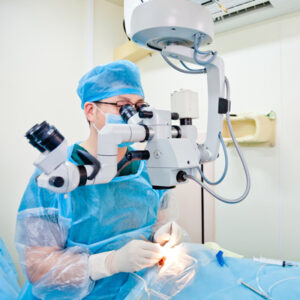Cataract
March 2021
by Liz Hillman
Editorial Co-Director
Ophthalmologists take several measures to prevent endophthalmitis after cataract surgery, but one thing they can’t control could have an impact on endophthalmitis rates: the weather. According to a study published in the Journal of Cataract & Refractive Surgery,endophthalmitis rates in South Korea peaked in the more hot and humid months.1 The study was based on data from the country’s Health Insurance Review & Assessment Service from July 2014–June 2017; climate data came from the Korea Meteorological Administration. Of the nearly 1.5 million cataract surgeries that took place during this timeframe, 29% occurred from March–May, 20% from June–August, 24% September–November, and 27% December–February. Postop endophthalmitis occurred in 951 eyes (incidence 0.063%). According to the researchers, incidences were most common in July with statistically significant monthly variation. There was also a statistically significant seasonal difference with more endophthalmitis incidences in the summer months, with incidences increasing with temperature, humidity, and precipitation level. “The univariate regression analysis showed that temperatures above 20°C, relative humidity above 60%, and precipitation above 100.0 mm were associated with increased odds of developing postoperative endophthalmitis,” Kim et al. wrote.
There was a statistically significant seasonal difference with more endophthalmitis incidences in the summer months, with incidences increasing with temperature, humidity, and precipitation level.
According to the researchers, previous studies present “conflicting results about the influence of season on the postoperative endophthalmitis incidence.” A U.S. study, for example, did not show seasonal variance in endophthalmitis rates.2
“There have been several studies on the incidences and risk factors of post-cataract endophthalmitis, however, the environmental effect on the occurrence of postoperative infection remained controversial,” said Moonjung Choi, MD, the study’s corresponding author. “Therefore, we decided to investigate whether there was seasonal variation of postoperative endophthalmitis incidences and whether the seasonality can be explained by the weather conditions.”
The differences in other studies that explored endophthalmitis and seasonality, Dr. Choi said, could be due to how the season is defined.
“We thought that this could be because while the season is usually defined by certain months of the year, the climate and weather patterns differ among the countries. The four seasons in Korea have distinct climatic characteristics with considerable variability in temperature and humidity. Therefore, we thought it would be ideal to investigate the association between climatic factors and the incidence of postoperative endophthalmitis. It would be interesting to find out if our results could be replicated in other regions of the world,” Dr. Choi said.
A study published in 2004 looked at the monthly prevalence of conjunctival bacteria in cataract surgery patients in Madrid, Spain. The study saw an increase in conjunctival bacteria from April–June, months when the temperature and humidity are higher in that region. The researchers in this study also saw a three times higher incidence of rehospitalization for endophthalmitis after cataract surgery in May and June, leading them to suggest that a seasonal pattern “could be considered as a predisposing condition for having postsurgical endophthalmitis in certain months.”3
Overall, Dr. Choi said hot and humid conditions, in general, provide optimal conditions for bacterial proliferation. She said doctors should be cautious in monitoring and assessing postoperative patients in such weather, especially those at risk for infection, such as hypertensive and diabetic patients and complicated cases.
About the physician
Moonjung Choi, MD
Department of Ophthalmology
Konyang University College of Medicine
Daejeon, South Korea
References
- Kim SH, et al. Seasonal variation in acute post-cataract surgery endophthalmitis incidences in South Korea. J Cataract Refract Surg. 2019;45:1711–1716.
- Keay L, et al. Postcataract surgery endophthalmitis in the United States: analysis of the complete 2003 to 2004 Medicare database of cataract surgeries. Ophthalmology. 2012;119:914–922.
- Rubio EF. Climatic influence on conjunctival bacteria of patients undergoing cataract surgery. Eye (Lond). 2004;18:778–784.
Relevant disclosures
Choi: None



